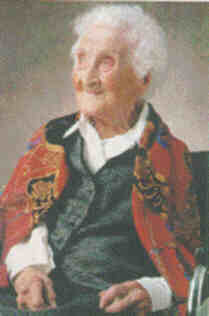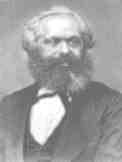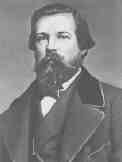 1882
Jean-Théodore Jean Dupas, French Art
Deco designer who died in 1964. — LINKS
1882
Jean-Théodore Jean Dupas, French Art
Deco designer who died in 1964. — LINKS1876 Constantin Brancusi, Romanian abstract sculptor who died on 16 March 1957.
1865 Grace Carpenter Hudson, US painter who died in 1937. — LINKS — Baby Bunting — The Seed Conjurer — Joseppa
1875 Jeanne Louise Calment, Arles, France, lived to be the verifiably oldest human at 122. She died on 4 August 1997. [photo taken on her 118th birthday >]
^ 1848 The Communist Manifesto by Marx and Engels is published.
The Communist Manifesto, written by Karl Marx, 64, with the assistance of Friedrich Engels (born 28 September 1820), is published in London by a group of German-born revolutionary socialists known as the Communist League. The political pamphlet — arguably the most influential in history — proclaimed that "the history of all hitherto existing society is the history of class struggles" and that the inevitable victory of the proletariat, or working class, would put an end to class society forever.
Originally published in German as Manifest der Kommunistischen Partei, the work had little immediate impact. Its ideas, however, reverberated with increasing force into the 20th century, and by 1950 nearly half the world's population lived under Marxist governments.
Karl Marx was born in Trier, Prussia, on 5 May 1818 — the son of a Jewish lawyer who converted to Lutheranism. He studied law and philosophy at the universities of Berlin and Jena and initially was a follower of G.W.F. Hegel, the 19th-century German philosopher who sought a dialectical and all-embracing system of philosophy.
In 1842, Marx became editor of the Rheinische Zeitung, a liberal democratic newspaper in Cologne. The newspaper grew considerably under his guidance, but in 1843 the Prussian authorities shut it down for being too outspoken. That year, Marx moved to Paris to co-edit a new political review. Paris was at the time a center for socialist thought, and Marx adopted the more extreme form of socialism known as communism, which called for a revolution by the working class that would tear down the capitalist world.
In Paris, Marx befriended Friedrich Engels, a fellow Prussian who shared his views and was to become a lifelong collaborator. In 1845, Marx was expelled from France and settled in Brussels, where he renounced his Prussian nationality and was joined by Engels. During the next two years, Marx and Engels developed their philosophy of communism and became the intellectual leaders of the working-class movement.
In 1847, the League of the Just, a secret society made up of revolutionary German workers living in London, asked Marx to join their organization. Marx obliged and with Engels renamed the group the Communist League and planned to unite it with other German worker committees across Europe. The pair were commissioned to draw up a manifesto summarizing the doctrines of the League.

 Back in Brussels, Marx [< photo] wrote The
Communist Manifesto in January 1848, using as a model a tract Engels
[photo >] wrote for the League in 1847. In early February,
Marx sent the work to London, and the League immediately adopted it as their
manifesto. Many of the ideas in The Communist Manifesto were not
new, but Marx had achieved a powerful synthesis of disparate ideas through
his materialistic conception of history. The Manifesto opens with the dramatic
words, "A spectre is haunting Europe — the spectre of communism," and
ends by declaring: "The proletarians have nothing to lose but their chains.
They have a world to win. Workers of the world, unite!" In The Communist
Manifesto, Marx predicted imminent revolution in Europe. The pamphlet had
hardly cooled after coming off the presses in London when revolution broke
out in France on February 22 over the banning of political meetings held
by socialists and other opposition groups. Isolated riots led to popular
revolt, and on February 24 King Louis-Philippe was forced to abdicate. The
revolution spread like brushfire across continental Europe. Marx was in
Paris on the invitation of the provincial government when the Belgian government,
fearful that the revolutionary tide would soon engulf Belgium, banished
him. Later that year, he went to the Rhineland, where he agitated for armed
revolt. The bourgeoisie of Europe soon crushed the Revolution of 1848, and
Marx would have to wait longer for his revolution. He went to London to
live and continued to write with Engels as they further organized the international
communist movement. In 1864, Marx helped found the International Workingmen's
Association — known as the First International — and in 1867 published
the first volume of his monumental Das Kapital — the foundation
work of communist theory. By his death in 1884, communism had become a movement
to be reckoned with in Europe. Twenty-three years later, in 1917, Vladimir
Lenin, a Marxist, led the world's first successful communist revolution
in Russia.
Back in Brussels, Marx [< photo] wrote The
Communist Manifesto in January 1848, using as a model a tract Engels
[photo >] wrote for the League in 1847. In early February,
Marx sent the work to London, and the League immediately adopted it as their
manifesto. Many of the ideas in The Communist Manifesto were not
new, but Marx had achieved a powerful synthesis of disparate ideas through
his materialistic conception of history. The Manifesto opens with the dramatic
words, "A spectre is haunting Europe — the spectre of communism," and
ends by declaring: "The proletarians have nothing to lose but their chains.
They have a world to win. Workers of the world, unite!" In The Communist
Manifesto, Marx predicted imminent revolution in Europe. The pamphlet had
hardly cooled after coming off the presses in London when revolution broke
out in France on February 22 over the banning of political meetings held
by socialists and other opposition groups. Isolated riots led to popular
revolt, and on February 24 King Louis-Philippe was forced to abdicate. The
revolution spread like brushfire across continental Europe. Marx was in
Paris on the invitation of the provincial government when the Belgian government,
fearful that the revolutionary tide would soon engulf Belgium, banished
him. Later that year, he went to the Rhineland, where he agitated for armed
revolt. The bourgeoisie of Europe soon crushed the Revolution of 1848, and
Marx would have to wait longer for his revolution. He went to London to
live and continued to write with Engels as they further organized the international
communist movement. In 1864, Marx helped found the International Workingmen's
Association — known as the First International — and in 1867 published
the first volume of his monumental Das Kapital — the foundation
work of communist theory. By his death in 1884, communism had become a movement
to be reckoned with in Europe. Twenty-three years later, in 1917, Vladimir
Lenin, a Marxist, led the world's first successful communist revolution
in Russia. There are many copies of the Manifesto online. Here are links to some in the original German:
Manifest der Kommunistischen Partei — Manifest der Kommunistischen Partei — Manifest der Kommunistischen Partei — Manifest der Kommunistischen Partei — Manifest der Kommunistischen Partei — Manifest der Kommunistischen Partei — Manifest der Kommunistischen Partei — Manifest der Kommunistischen Partei — Manifest der Kommunistischen Partei
WERKEN VON MARX UND ENGELS (auf Deutsch) — Marx–Engels Selected Works
EXTENSIVE LINKS TO MARK–ENGELS ONLINE in English, German, French, Swedish
1836 Clement-Philibert-Léo Delibes, Saint-Germain-du-Val France, opéra and ballet composer (Coppélia). He died on 16 January 1891.
1830 Henry Wallis, English Pre-Raphaelite painter who died in December 1916. — MORE ON WALLIS AT ART “4” FEBRUARY — LINKS — Elaine — The Death of Chatterton
1823 Pierre Laffitte, French philosopher who died on 04 January 1903.
1815 Jean Louis Ernest Meissonier, French artist who died on 31 January 1891.
1804 First locomotive, Richard Trevithick's, runs for first time, in Wales
1779 Friedrich Karl von Savigny, German jurist and legal scholar who died on 25 October 1861.
1745 Joseph-Laurent Malaine (or Malines, Mallache), French artist who died on 05 May 1809.
1728 Peter III Kiel Germany, Russian tsar (1761-62), husband of Catherine
1686 Frans Xaver Hendrik Verbeeck, Flemish artist who died on 28 May 1755.
1630 Cornelis Droogsloot (or Droochslott), Dutch artist who died after 1673.
1627 Philips-Ausgustyn Immenraet, Flemish painter who died on 25 September 1679. — The Wolf Hunt
1591 Girard Desargues, mathematician
1575 Marten Pepyn, Flemish artist who died in 1642.